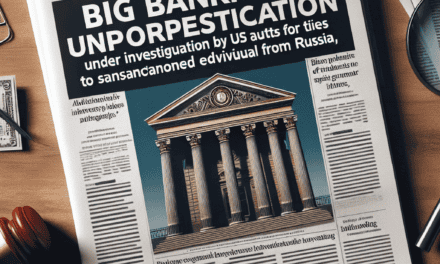“Navigating the Storm: Steadying Strategies in Uncertain Markets”
Introduction
Markets are on edge as they navigate a landscape fraught with high event risk and pervasive uncertainty on Wall Street. Investors are grappling with a confluence of factors that threaten to disrupt financial stability, including geopolitical tensions, fluctuating economic indicators, and unpredictable policy shifts. This environment of heightened volatility is prompting market participants to reassess their strategies and brace for potential turbulence. As they seek to mitigate risks and capitalize on opportunities, the focus is on understanding the implications of these uncertainties and preparing for a range of possible outcomes.
Understanding Event Risk: How It Impacts Market Volatility
In the ever-evolving landscape of global finance, understanding the concept of event risk is crucial for investors and market participants. Event risk refers to the potential for significant market volatility triggered by unforeseen events, which can range from geopolitical tensions and economic data releases to corporate earnings announcements and natural disasters. As Wall Street grapples with uncertainty, the implications of event risk become increasingly pronounced, necessitating a closer examination of how these events can impact market dynamics.
To begin with, it is essential to recognize that event risk is inherently unpredictable, making it a formidable challenge for investors seeking to safeguard their portfolios. Unlike systematic risks, which are inherent to the entire market, event risks are often isolated incidents that can have far-reaching consequences. For instance, a sudden geopolitical conflict can lead to a sharp increase in oil prices, thereby affecting energy stocks and broader market indices. Similarly, unexpected changes in monetary policy by central banks can lead to fluctuations in currency values, impacting international trade and investment flows.
Moreover, the interconnectedness of global markets means that event risk in one region can have ripple effects across the world. This interconnectedness was starkly illustrated during the 2008 financial crisis, where the collapse of major financial institutions in the United States led to a global economic downturn. In today’s context, with Wall Street facing uncertainty due to factors such as inflationary pressures, interest rate hikes, and political developments, the potential for event risk to disrupt markets is heightened.
In addition to geopolitical and economic factors, corporate events also play a significant role in shaping market volatility. Earnings announcements, mergers and acquisitions, and changes in corporate leadership can all serve as catalysts for market movements. For example, a positive earnings report from a major corporation can boost investor confidence and drive stock prices higher, while a disappointing report can have the opposite effect. Consequently, investors must remain vigilant and informed about corporate developments to effectively manage event risk.
Furthermore, technological advancements have introduced new dimensions to event risk. The rise of algorithmic trading and high-frequency trading has increased market sensitivity to news and events, leading to more pronounced and rapid price movements. In this environment, even minor events can trigger significant volatility, as automated trading systems react instantaneously to new information. This underscores the importance of robust risk management strategies and the need for investors to stay abreast of technological trends that may influence market behavior.
In light of these considerations, it is imperative for market participants to adopt a proactive approach to managing event risk. Diversification remains a fundamental strategy, as spreading investments across different asset classes and geographic regions can help mitigate the impact of isolated events. Additionally, employing hedging techniques, such as options and futures contracts, can provide a layer of protection against adverse market movements.
In conclusion, as Wall Street navigates a period of uncertainty, understanding and managing event risk is more important than ever. By recognizing the potential triggers of market volatility and implementing effective risk management strategies, investors can better position themselves to weather the challenges posed by unforeseen events. As the global financial landscape continues to evolve, staying informed and adaptable will be key to successfully navigating the complexities of event risk and its impact on market dynamics.
Strategies for Investors During High Event Risk Periods
In times of heightened event risk, investors often find themselves navigating a landscape fraught with uncertainty and potential volatility. The current climate on Wall Street exemplifies such a scenario, where geopolitical tensions, economic data releases, and central bank policy decisions converge to create a complex environment for market participants. As investors brace for these high-stakes events, it becomes imperative to adopt strategies that not only mitigate risk but also capitalize on potential opportunities.
One of the primary strategies during periods of high event risk is diversification. By spreading investments across a variety of asset classes, sectors, and geographic regions, investors can reduce the impact of adverse events on their portfolios. Diversification acts as a buffer, ensuring that a downturn in one area does not disproportionately affect the overall portfolio. For instance, while equities may experience volatility due to economic data releases, bonds or commodities might offer stability or even gains, thereby balancing potential losses.
In addition to diversification, maintaining a focus on liquidity is crucial. During uncertain times, the ability to quickly adjust positions in response to new information is invaluable. Investors should ensure that a portion of their portfolio is allocated to liquid assets, which can be easily bought or sold without significantly affecting their price. This flexibility allows investors to respond swiftly to market movements, whether to capitalize on emerging opportunities or to cut losses in the face of adverse developments.
Moreover, employing hedging strategies can provide an additional layer of protection. Instruments such as options and futures contracts can be used to hedge against potential downside risks. For example, purchasing put options on a stock or index can serve as insurance against a decline in value, while futures contracts can lock in prices for commodities or currencies, shielding investors from unfavorable price movements. These tools, when used judiciously, can help manage risk without necessitating a complete overhaul of the investment portfolio.
Furthermore, staying informed and maintaining a disciplined approach is essential during high event risk periods. Investors should keep abreast of economic indicators, geopolitical developments, and central bank communications, as these factors can significantly influence market sentiment and direction. By staying informed, investors can make more educated decisions and avoid being swayed by short-term market noise. A disciplined approach, characterized by adherence to a well-defined investment strategy and risk management framework, can prevent emotional reactions that often lead to suboptimal decision-making.
Additionally, it is important for investors to reassess their risk tolerance and investment objectives in light of the prevailing market conditions. High event risk periods may necessitate a temporary adjustment in risk exposure, aligning the portfolio with the investor’s comfort level and long-term goals. This reassessment ensures that the investment strategy remains aligned with the investor’s financial situation and market outlook.
In conclusion, navigating high event risk periods requires a multifaceted approach that combines diversification, liquidity management, hedging, informed decision-making, and a reassessment of risk tolerance. By implementing these strategies, investors can better position themselves to weather the uncertainties of Wall Street and potentially capitalize on the opportunities that arise amidst the volatility. As markets brace for the challenges ahead, a proactive and strategic approach will be key to achieving investment success in an uncertain environment.
Wall Street Uncertainty: Historical Lessons for Today’s Markets
As markets brace for high event risk amid Wall Street uncertainty, investors and analysts alike are turning to historical precedents to navigate the turbulent waters of today’s financial landscape. The lessons of the past offer valuable insights into how markets have responded to uncertainty, providing a framework for understanding potential outcomes in the current environment. By examining historical events, market participants can better anticipate the challenges and opportunities that lie ahead.
One of the most instructive periods in financial history is the Great Depression of the 1930s, which serves as a stark reminder of the profound impact that economic uncertainty can have on global markets. During this time, a combination of speculative excess, regulatory failures, and economic mismanagement led to a prolonged period of economic hardship. The lessons from this era underscore the importance of robust regulatory frameworks and the need for vigilance in monitoring market dynamics. As we face today’s uncertainties, these historical insights remind us of the critical role that sound economic policies play in maintaining market stability.
Transitioning to more recent history, the financial crisis of 2008 offers another pertinent example of how markets react to uncertainty. The collapse of major financial institutions and the subsequent global recession highlighted the interconnectedness of modern financial systems. This crisis underscored the necessity for transparency and accountability within financial markets, as well as the importance of international cooperation in addressing systemic risks. In the current climate of uncertainty, these lessons are particularly relevant as markets grapple with geopolitical tensions, trade disputes, and the lingering effects of the COVID-19 pandemic.
Moreover, the dot-com bubble of the late 1990s and early 2000s provides further insights into the consequences of speculative excess and market exuberance. The rapid rise and fall of technology stocks during this period serve as a cautionary tale about the dangers of overvaluation and the importance of due diligence in investment decisions. As technology continues to drive market innovation today, investors must remain vigilant in assessing the true value of emerging technologies and avoid the pitfalls of irrational exuberance.
In addition to these historical events, the lessons learned from past market corrections emphasize the importance of diversification and risk management. During times of uncertainty, a well-diversified portfolio can help mitigate potential losses and provide a buffer against market volatility. Investors are reminded of the adage that diversification is the only free lunch in finance, as it allows for a more balanced approach to risk-taking.
Furthermore, the role of central banks in managing economic uncertainty cannot be overstated. Historical precedents demonstrate that timely and decisive action by central banks can help stabilize markets and restore investor confidence. As we navigate the current landscape, the actions of central banks will be closely scrutinized, with market participants keenly aware of the potential implications for interest rates, inflation, and overall economic growth.
In conclusion, while the current environment of Wall Street uncertainty presents significant challenges, historical lessons provide valuable guidance for navigating these turbulent times. By drawing on the experiences of the past, market participants can better understand the dynamics at play and make informed decisions that account for both risks and opportunities. As we move forward, the insights gleaned from history will continue to serve as a vital tool in managing the complexities of today’s financial markets.
The Role of Central Banks in Mitigating Market Risks

In the current financial landscape, the role of central banks has become increasingly pivotal in mitigating market risks, especially as markets brace for high event risk amid Wall Street uncertainty. Central banks, as key financial institutions, are tasked with the responsibility of maintaining economic stability and fostering conditions conducive to sustainable growth. Their actions, particularly in times of uncertainty, can significantly influence market dynamics and investor sentiment.
One of the primary tools at the disposal of central banks is monetary policy, which involves the manipulation of interest rates and the money supply to achieve macroeconomic objectives. By adjusting interest rates, central banks can influence borrowing and spending behaviors, thereby impacting economic activity. For instance, in times of economic downturn or heightened market volatility, central banks may lower interest rates to encourage borrowing and investment, aiming to stimulate economic growth. Conversely, in periods of overheating economies or rising inflation, they might increase rates to temper excessive spending and borrowing.
Moreover, central banks play a crucial role in providing liquidity to financial markets, especially during periods of stress. Through mechanisms such as open market operations and quantitative easing, they can inject liquidity into the financial system, ensuring that banks and other financial institutions have access to the necessary funds to operate smoothly. This liquidity provision is vital in preventing credit crunches and ensuring that financial markets continue to function efficiently, even in the face of significant disruptions.
In addition to these traditional tools, central banks have increasingly adopted forward guidance as a strategy to manage market expectations. By communicating their future policy intentions clearly, central banks can influence investor behavior and market outcomes. This transparency helps reduce uncertainty, as market participants can better anticipate the trajectory of monetary policy and adjust their strategies accordingly. Forward guidance thus serves as a powerful tool in stabilizing markets, particularly during times of heightened event risk.
Furthermore, central banks often collaborate with other financial authorities and international organizations to address systemic risks that transcend national borders. In an interconnected global economy, financial shocks can quickly spread across markets and regions, necessitating coordinated responses. Central banks, therefore, engage in dialogue and cooperation with their counterparts to ensure a cohesive approach to risk management, thereby enhancing the resilience of the global financial system.
However, the effectiveness of central banks in mitigating market risks is not without challenges. The current environment of low interest rates and high debt levels limits the scope for traditional monetary policy interventions. Additionally, the rise of unconventional monetary policy measures, while necessary in some contexts, raises concerns about long-term financial stability and the potential for asset bubbles. Central banks must navigate these complexities carefully, balancing the need for immediate risk mitigation with the imperative of maintaining long-term economic health.
In conclusion, as markets brace for high event risk amid Wall Street uncertainty, the role of central banks in mitigating market risks remains indispensable. Through a combination of monetary policy tools, liquidity provision, forward guidance, and international cooperation, central banks strive to maintain economic stability and foster confidence in financial markets. While challenges persist, their proactive and adaptive strategies are crucial in navigating the uncertainties of the modern financial landscape, ensuring that markets remain resilient in the face of potential disruptions.
Analyzing Market Trends Amid Economic Uncertainty
As global markets navigate a landscape fraught with uncertainty, investors are increasingly focused on the high event risk emanating from Wall Street. This heightened sense of caution is driven by a confluence of factors, including fluctuating economic indicators, geopolitical tensions, and evolving monetary policies. In this complex environment, market participants are keenly aware of the potential for significant volatility, prompting a more strategic approach to investment decisions.
To begin with, the economic backdrop remains a critical factor influencing market sentiment. Recent data releases have painted a mixed picture, with some indicators suggesting resilience while others point to potential vulnerabilities. For instance, employment figures have shown steady growth, yet inflationary pressures continue to pose challenges for policymakers. This duality creates a scenario where market participants must weigh the prospects of economic expansion against the risks of overheating and subsequent policy tightening.
Moreover, geopolitical developments add another layer of complexity to the market landscape. Ongoing trade negotiations, regional conflicts, and shifting alliances contribute to an atmosphere of unpredictability. Investors are acutely aware that any escalation in these areas could have far-reaching implications for global supply chains and economic stability. Consequently, there is a heightened focus on monitoring geopolitical news and assessing its potential impact on market dynamics.
In addition to these factors, central bank policies remain a pivotal element in shaping market trends. The Federal Reserve, in particular, plays a crucial role in setting the tone for global monetary conditions. Recent statements from Fed officials have underscored a commitment to data-driven decision-making, yet the path forward remains uncertain. Market participants are closely scrutinizing every communication from the central bank, seeking clues about the future trajectory of interest rates and quantitative easing measures. This scrutiny reflects the broader concern that any misstep in policy could exacerbate market volatility.
As investors grapple with these uncertainties, there is a growing emphasis on risk management and portfolio diversification. Traditional asset classes, such as equities and bonds, are being re-evaluated in light of their potential vulnerabilities to economic and geopolitical shocks. At the same time, alternative investments, including commodities and real estate, are gaining traction as potential hedges against market turbulence. This shift underscores the importance of a balanced approach to investment, where diversification serves as a buffer against unforeseen events.
Furthermore, technological advancements are playing an increasingly important role in shaping market behavior. The rise of algorithmic trading and artificial intelligence-driven analytics has transformed the way investors approach decision-making. These tools offer the potential for enhanced precision and efficiency, yet they also introduce new risks, particularly in terms of market liquidity and systemic stability. As such, regulators and market participants alike are grappling with the implications of these technological shifts, seeking to harness their benefits while mitigating potential downsides.
In conclusion, the current market environment is characterized by a high degree of uncertainty, driven by a complex interplay of economic, geopolitical, and technological factors. As Wall Street braces for potential volatility, investors are adopting a more cautious and strategic approach, emphasizing risk management and diversification. By staying attuned to evolving trends and maintaining a flexible investment strategy, market participants can better navigate the challenges and opportunities that lie ahead.
Diversification Tactics to Navigate Uncertain Markets
In the current financial landscape, investors are increasingly aware of the high event risk that looms over Wall Street, prompting a reevaluation of traditional investment strategies. As uncertainty becomes a defining characteristic of the markets, diversification emerges as a crucial tactic for navigating these turbulent waters. The concept of diversification, while not new, takes on renewed significance in an environment where geopolitical tensions, economic policy shifts, and unexpected global events can dramatically impact market stability.
To begin with, diversification involves spreading investments across various asset classes, sectors, and geographical regions to mitigate risk. This strategy is particularly relevant in times of uncertainty, as it reduces the reliance on any single investment or market segment. By allocating assets across a broad spectrum, investors can potentially cushion the impact of adverse events on their portfolios. For instance, while equities may suffer during a market downturn, bonds or commodities might perform better, thereby balancing overall portfolio performance.
Moreover, the current climate of uncertainty underscores the importance of including alternative investments in a diversified portfolio. These can range from real estate and private equity to hedge funds and commodities. Alternative investments often exhibit low correlation with traditional asset classes, providing an additional layer of protection against market volatility. For example, real estate investments can offer stable returns even when stock markets are underperforming, while commodities like gold are traditionally seen as safe havens during economic turmoil.
In addition to asset class diversification, geographical diversification is another critical consideration. By investing in international markets, investors can reduce their exposure to domestic economic fluctuations and benefit from growth opportunities in emerging markets. However, it is essential to be mindful of the risks associated with foreign investments, such as currency fluctuations and political instability. Therefore, a balanced approach that considers both developed and emerging markets can be advantageous.
Furthermore, sector diversification is equally important in managing high event risk. Different sectors of the economy react differently to various economic conditions. For instance, technology stocks may thrive in an environment of innovation and digital transformation, while consumer staples might offer stability during economic downturns. By diversifying across sectors, investors can better position themselves to capitalize on growth opportunities while minimizing potential losses.
In light of these considerations, it is crucial for investors to regularly review and adjust their portfolios to ensure they remain aligned with their risk tolerance and investment objectives. This involves not only assessing the performance of individual investments but also understanding the broader economic and geopolitical landscape. Staying informed about market trends and potential risks can help investors make more informed decisions and adapt their strategies as needed.
In conclusion, as Wall Street grapples with high event risk and uncertainty, diversification remains a fundamental strategy for investors seeking to protect their portfolios and achieve long-term financial goals. By spreading investments across various asset classes, sectors, and geographical regions, investors can mitigate risk and enhance their ability to navigate the complexities of today’s markets. While diversification does not eliminate risk entirely, it provides a robust framework for managing uncertainty and capitalizing on opportunities in an ever-changing financial environment. As such, it is an indispensable tool for investors aiming to safeguard their assets and secure their financial future amidst the challenges of the modern market landscape.
The Impact of Geopolitical Events on Global Markets
In recent years, the global financial markets have become increasingly sensitive to geopolitical events, with investors closely monitoring developments that could potentially disrupt economic stability. As Wall Street grapples with uncertainty, the impact of geopolitical tensions on global markets has become a focal point for analysts and traders alike. The interconnectedness of today’s economies means that events in one region can have far-reaching consequences, influencing investor sentiment and market dynamics across the globe.
One of the primary reasons geopolitical events have such a profound impact on markets is the uncertainty they introduce. Investors typically seek stability and predictability, and geopolitical tensions often bring about the opposite. For instance, conflicts or diplomatic standoffs can lead to fluctuations in commodity prices, particularly oil and gas, as these resources are often at the center of geopolitical disputes. When tensions rise in oil-rich regions, fears of supply disruptions can drive prices up, affecting not only energy markets but also broader economic conditions.
Moreover, geopolitical events can lead to shifts in trade policies and economic sanctions, further complicating the global economic landscape. Trade wars or sanctions can disrupt supply chains, alter competitive dynamics, and lead to retaliatory measures, all of which can have significant implications for businesses and investors. For example, the trade tensions between the United States and China in recent years have led to volatility in stock markets worldwide, as investors weigh the potential impact on global growth and corporate earnings.
In addition to direct economic consequences, geopolitical events can also influence investor behavior through changes in risk perception. During times of heightened geopolitical tension, investors often seek safe-haven assets, such as gold or government bonds, which are perceived as more stable in uncertain times. This flight to safety can lead to increased volatility in equity markets, as funds are reallocated in response to changing risk appetites.
Furthermore, central banks and policymakers are not immune to the effects of geopolitical events. In an effort to mitigate potential economic fallout, they may adjust monetary policies, such as interest rates or quantitative easing measures, to stabilize markets and support growth. These policy responses can, in turn, influence currency valuations and capital flows, adding another layer of complexity to the global financial system.
As Wall Street navigates this landscape of uncertainty, market participants must remain vigilant and adaptable. The ability to anticipate and respond to geopolitical developments is crucial for managing risk and capitalizing on opportunities. This requires a comprehensive understanding of the geopolitical landscape, as well as the potential economic and market implications of various scenarios.
In conclusion, the impact of geopolitical events on global markets is multifaceted and significant. As investors brace for high event risk amid Wall Street uncertainty, the need for careful analysis and strategic decision-making becomes ever more apparent. By staying informed and agile, market participants can better navigate the challenges posed by geopolitical tensions and position themselves for success in an increasingly complex and interconnected world.
Q&A
1. **What is the main concern for markets amid Wall Street uncertainty?**
Markets are primarily concerned about high event risk, which includes potential economic data releases, geopolitical tensions, and central bank policy decisions that could impact market stability.
2. **How are investors reacting to the current market conditions?**
Investors are adopting a cautious approach, often seeking safe-haven assets or diversifying their portfolios to mitigate potential risks associated with market volatility.
3. **What role do central banks play in the current market environment?**
Central banks are crucial as their policy decisions, such as interest rate changes or quantitative easing measures, can significantly influence market sentiment and economic outlook.
4. **Which economic indicators are closely watched by market participants?**
Key economic indicators include inflation rates, employment figures, GDP growth, and consumer confidence indices, as these provide insights into the economic health and potential future market movements.
5. **What geopolitical factors are contributing to market uncertainty?**
Geopolitical factors such as trade tensions, conflicts, and political instability in key regions can create uncertainty and affect global markets by disrupting trade and investment flows.
6. **How does market volatility impact investment strategies?**
Increased market volatility often leads investors to reassess their risk tolerance, potentially shifting towards more conservative investments or employing hedging strategies to protect against losses.
7. **What are some potential outcomes of the current market uncertainty?**
Potential outcomes include increased market volatility, shifts in asset prices, changes in investor sentiment, and potential adjustments in monetary policy by central banks to stabilize markets.
Conclusion
The conclusion is that markets are currently navigating a period of heightened uncertainty due to various risk factors impacting Wall Street. Investors are on edge, anticipating potential volatility driven by economic indicators, geopolitical tensions, and policy decisions. This environment necessitates cautious strategies and vigilant monitoring of market developments to mitigate risks and capitalize on opportunities.





